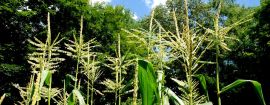Several weeks ago, Genevieve Ko published a fascinating recipe for Lemon Ricotta Pancakes in the Sunday New York Times. She used superlatives like “most tender,” “fluffy,” “light” and “comforting,” and we just had to try them.
The pancakes are light because the recipe has 3 eggs, buttermilk, ricotta and only ¾ cup of flour. And the unique part of her version is that the batter also has some grated lemon zest. To counter that, she recommends serving them with a blueberry sauce. Here is her recipe:
Ingredients
- ¾ cup flour
- 1 ½ tsp baking powder
- ¾ tsp salt
- ¼ cup sugar
- 1 lemon
- 1 ½ tsp vanilla extract
- 3 large eggs
- ¾ cup whole milk ricotta
- ¼ cup buttermilk
- 2 tsp melted butter
- Heat a griddle to “medium low.” We chose 350˚ F.
- Whisk the flour, baking powder, and salt in a small bowl.
- Put the sugar in a large bowl and grate the lemon zest into it, Work in with your fingers.
- Mix in the vanilla
- Add the eggs and whisk until foamy on top.
- Add the flour, ricotta and buttermilk and whisk until uniform.
- Butter the griddle generously and drop ¼ cup portions onto it. Cook 2-3 minutes until bubbles begin to from. Turn each pancake gently and cook about 2 more minutes.
- Serve with butter and blueberry sauce.
Blueberry sauce
- ! pint blueberries
- ½ cup sugar
- ½ cup water
- 2 tsp cornstarch
Place all ingredients in a saucepan, mix and heat to a boil. Cook for about 5 minutes, until thickened.
There is no doubt that these are light, delicious pancakes. Ko says the recipe makes 12-14 pancakes, but since they are so small and not all that filling, this recipe serves just a bit more than two people. We each ate two stacks of 3 pancakes without any trouble. You could have to double it to serve four. And, of course, you could omit the lemon zest if you wanted to serve them with maple syrup.
Grandma’s recipe
This is our old family recipe that was handed down from my mother’s mother, Edna Neely, who probably learned the recipe in the latter part of the 19th century. The copy I got came from her daughter, my aunt Elsie, many years ago. It is a simple recipe that you can remember as 2-2-2-1-1-1/2:
- 2 cups flour
- 2 tsp baking powder
- 2 eggs
- 1 Tb sugar
- 1 tsp baking soda
- ½ tsp salt
- Buttermilk
Over time, I’ve reduced the baking soda to about ¾ tsp so that the buttermilk flavor comes through more strongly.
- Mix the dry ingredients together.
- Break the eggs into the mixture and add buttermilk to make a “thickish batter.”
- Cook on a griddle at 375˚ F until bubble form and then turn them and cook another two minutes.
How they differ
We usually make bigger pancakes, using maybe 1/3 of a cup of batter each, but you certainly can make them smaller like the ones in Ko’s recipe. They are nearly as light as Ko’s and much less work. It is also easy to make, say a 1-1/2 recipe to serve more people, but the basic recipe will serve 3-4.
I’ll probably make Ko’s recipe from time to time because they are really good with blueberry sauce, but it is so much more work than Grandma’s recipe and if you put a stack of 3 ¼-cup sized pancakes from each recipe side by side, the difference is relatively small.
We tried cooking this recipe at the lower temperature as Ko recommends, and this works fine too. They just take slightly longer to cook. However, we did find that the lower temperature cooked those frozen sausage patties more uniformly without burning them.



















